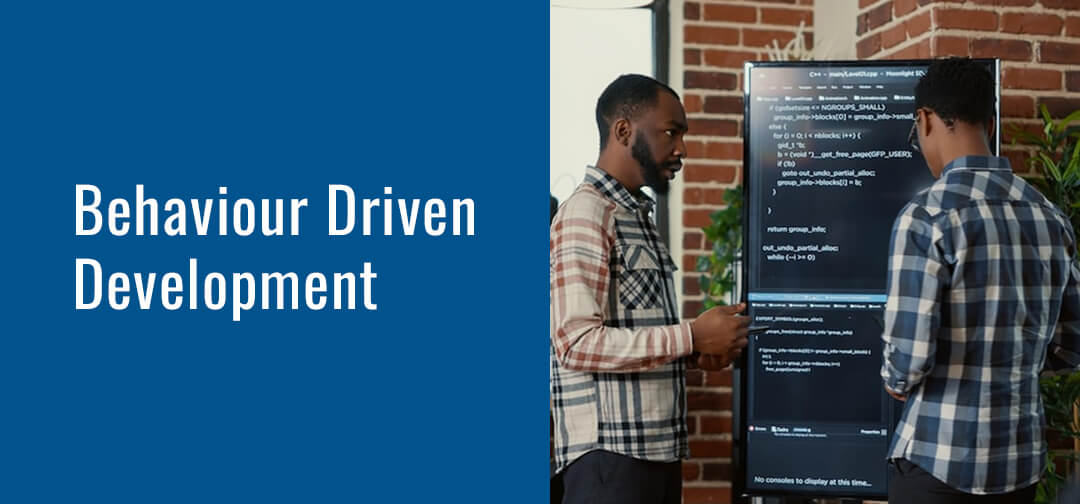Behaviour Driven Development

BDD (Behaviour Driven Development) places a special emphasis on offering a shared process and shared tools promoting communication among software developers and business analysts on collaborating on software development, or you might say being on the same page. Dan North is the person who helped BDD cultivate. He stated that "BDD is using example at multiple levels to create a shared understanding and surface uncertainty to deliver software that matter." The following are some examples of how BDD are written:
- Transformed to an Executive specification
- Useful for acceptance tests
Key Elements of Behaviour Driven Development
BDD Focuses on
- Giving stakeholders, business analysts, and software developers a shared process and set of tools to facilitate communication will help them work together to develop software with the goal of producing something with commercial value.
- What a system must accomplish, not how it should be put into operation.
- Improving visibility and readability.
- Making sure that the software not only meets customer expectations but also works as intended.
Feature File for BDD
- Feature: This would describe the current test script that must be executed.
- Scenario: a scenario would outline the steps and expected results for a specific test case
- Background: The background describes the actions that would be taken before each step.
- Scenario Outline: Using scenario outline, we can run the same scenarios for various sets of data. The information is presented in a tabular format with separators of | |. The step definitions can be parameterized by enclosing the column header in angle brackets (>). Double quotes must be used in the table rather than the step definition for each parameter.
- Given: This specifies the environment in which the text is to be executed. Using data tables, a step can also be parameterized.
- When: It specifies the test action to be executed
- Then: It outlines the anticipated result of the test.
Parameters can be passed within double quotes ("") in each step definition. The format will be read as regex. For various features, backgrounds, or scenarios, tags can be offered. The tags would be useful in identifying the precise scripts that would be executed.
What Is Cucumber?
One testing framework that aids in closing the gap between business managers and software developers is cucumber. Tests are written in clear and simple language to make them easier for laymen to understand and are based on the BDD (Behavior Driven Development) style. Software development teams can write plain text descriptions of how software should behave using cucumber. The text is written in a business-readable domain-specific language and serves as documentation, automated tests, and a development tool all in one. A tool for lean and agile teams to automate functional tests is called cucumber. It backs Agile Acceptance Testing, Behavior Driven Development, and specification by example. With the help of "Given, When, Then" (GWT) sentence fragments, the Cucumber Ruby tool allows users to specify behaviors in natural language. This language is known as Gherkin.
Cucumber only cares about the Gherkin keywords "Given," "When," "Then," and "And" (plus a few others); everything else is just matched against your regular expressions. This allows for incredibly flexible syntax. Your step definition blocks receive any tokens that your regexes' capture groups manage to capture as parameters. You can combine cucumber with selenium, witir, capybara, and other ingredients. Many other languages, including Perl, PHP, Python, and Net, are supported by Cucumber. We will focus on Cucumber with Java as the language in this tutorial.
What's Gherkin?
The domain-specific language Gherkin was developed specifically for behaviour descriptions. You have the option to take logic details out of behaviour testing. Gherkin performs automated testing as well as serving as the documentation for your project. Let's first observe a straightforward example expressed in gherkin since it is a structured language that adheres to specific syntactic rules.
Feature: A user search function
Sinceit will allow customers to filter products, this functionality is crucial.
Scenario: A user types the exact product name they are looking for into a search query. All items with names that are similar should be presented.
- Given: The user is on www.myshopingsite.com's home page.
- When: A user checks for Cell Phones
- Then: the listings of Cell Phones should be refreshed on the search page.
Gherkin contains a list of keywords that describe each scenario's many premises. As we can see above, bold texts are the keywords. The following are the most important things to remember while discussing the gherkin test structure:
- The test is written in simple English, which is the same across all of the project team's domains.
- The way this test is set up makes it suitable for automated reading. Consequently, while defining the scenario, simultaneously you can create automation tests.
Service Offerings
Information/ Data Sharing
We provide analysis of automation test requirements, strategy and plan, test estimation, etc.
Software Development
Using concepts from object-oriented analysis, design, and domain-driven design to offer software dev.
Behaviour Driven Development
It helps us collaborate with everyone, which calls for a cross-functional team made up of software etc
Prevent Technical Time Wastage
Blue Summit helps you prevent technical time wastage due to resistance to refactoring code.
Implement Individual Tools
Blue Summit can assist you in implementing individual tools to help you roll-out a wide range.
Careful and detailed observation
To assist you in creating a holistic solution plan to go forward, we will take the time to carefully.
Continuous support
Break/fix support means we'll be there to get you back up if an application goes down.
Wide range of testing services
We offer various types of testing, primarily for enterprise/web applications.
Skills Matrix

- 7+ years of extensive expertise in an agile environment with automation testing.
- 10+ years of practical expertise with automation (Selenium, Java, Cucumber, Serenity).
- Working knowledge of Jenkin or Azure DevOps as continuous integration technologies.
- Knowledge of test strategies, test scripts, design, refactoring, execution, and maintenance of automation frameworks.
- We comprehend and create hybrid, data-driven, keyword-driven, and behavior-driven automation frameworks.
- In order to test applications throughout all stages of the Software Development Life Cycle, we use automated technologies (SDLC). We are familiar with the methods and tools used to automate various test-related tasks, including test planning, management, reporting, data generation, and defect tracking.
- We put the test approach into practice by creating, running, and producing test reports.
- Ensure timely reporting to client partners and the provision of project-related data as needed in the relevant systems.
- Working experience of the BDD tools Selenium, Cucumber, and TestNG/Junit, as well as knowledge of Gherkin, Ant/Maven, and Jenkins
- We also have the expertise to design, develop, and support frameworks for any type of test.
- Proficiency with test management and bug tracking software
- In the area of testing, such as unit testing, integration testing, performance/stress/scalability testing, automated browser testing, visual regression testing, user testing, security penetration testing, etc., we are all over the place.
- Capable of identifying the gaps between manual and automated testing and putting a fix in place for them
- Experience with version control systems like GIT, SVN, etc., as well as version control tools and test management solutions like HP ALM.
- Effective for testing Web services like SoapUI, PostMan, etc.
- Strong programming skills in Java (Collections API, File I/O, Database I/O, and JSON).
Our Development Process
Understanding Requirement
We assign a exclusive team to work with you and understand all the concepts and requirements of your project.User Interface Design
At Blue Summit, user needs come first and our products follow industry UX design standards.Software Architecture
While Agile questions upfront analysis, some solution architecture is necessary for effectiveness.Implementation
Upon obtaining design approval, we build the product according to the client's requirements.Deployment
After rigorous testing and QA, our experts will launch your product on app stores and web browsers. Get ready to see your masterpiece live!Support
We regularly monitor and maintain the application and environment to ensure proper functionality.Request A Quote
Ready to reach your peak?
Contact us today for an initial consultation.
We would be pleased to provide you with information about our tech services, and help you succeed. Blue Summit Technologies have worked with global clients to improve efficiency and productivity, by empowering them with right technologies, tools and software solutions. For more than 20 years, BST teams have helped customers achieve their IT system and software development goals.
If you require support with employee badge printing, timekeeping, site security, or managed services, we have the right answers and the right teams to work. To request a quote, kindly fill out the form on our website and we will revert back on it soonest we can!














